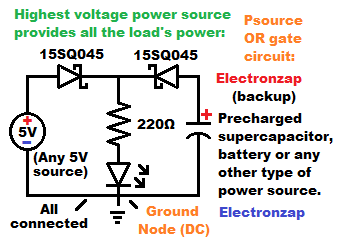Table of Contents
Two completely independent power supplies can be capable of powering the same load at all times with the use of a diode OR gate. Usually, one power source will power the load, and the other one will take over instantly if the first one fails to provide power for some reason. Whichever power source has the highest voltage at any given time, will be the one powering the circuit.

The circle with “5V” in it is a schematic symbol for a 5 volt voltage source. Which can be a bench power supply set at 5V. To keep the 5V source from interacting with another power source attached to the load, a Schottky diode has been added in series with the 5V source.
A supercapacitor has also been added to this circuit in order to be able to provide power to the load. It also has a series Schottky diode so that it will not interact with the other power source connected to the load. The supercapacitor needs to be precharged in a circuit like this. It’s voltage goes down linearly as current is drawn from it.
I used a 4 farad supercapacitor that can be charged to 5.5V in the demonstration circuit below. A battery or other power source can be used instead. The circuit will likely need to be modified to work at a higher or lower voltage if you use one or more batteries. This circuit is really just a demonstration circuit. A starting point for designing a more practical circuit.
The 15SQ045 Schottky diode acts like a regular silicon rectifier diode, but has a lower forward voltage than regular silicon rectifier diode. The 15SQ045 can pass up to 15A of current while forward biased and block up to 45 volts while reverse biased. That’s what the 2 numbers in the part number stand for. It has larger leads than most components though. So it can not be plugged directly into a breadboard. Therefore, I plugged them into a terminal block which can be plugged into a breadboard. Shown in the video below.
Video below goes live 6pm CST on 3 May 2023.
Good topics to check out next:
To support this site, check out the following links:
- Check out my YouTube videos! https://www.youtube.com/c/Electronzap/videos
- Products I used in my videos or otherwise think look like a good buy. As an Amazon associate, I earn from qualifying purchases. https://www.amazon.com/shop/electronzapdotcom
- Information on this site is not guaranteed to be accurate. Always consult the manufacturer info/datasheet of parts you use. Research the proper safety precautions for everything you do.
- Electronzap is a participant in the Amazon Services LLC Associates Program, an affiliate advertising program designed to provide a means for sites to earn advertising fees by advertising and linking to amazon.com.